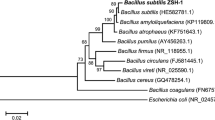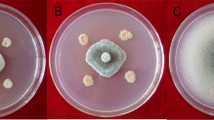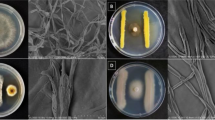Abstract
An endophytic bacterial strain, isolated from Fragaria × ananassa roots, and its antifungal activity against Colletotrichum nymphaeae were investigated under in vitro, in vivo, and greenhouse experiments. Bacterial isolate was identified as Bacillus atrophaeus strain DM6120 using phenotypic, biochemical, and molecular phylogenetic analysis of the 16S rDNA gene sequences. Bacterial strain DM6120 suppressed mycelial growth of C. nymphaeae (54.92%) using dual-culture method. The non-volatile compounds produced by DM6120 inhibited mycelial growth and conidial germination of C. nymphaeae by 74.12% and 80.80%, respectively. However, inhibition percentage of mycelial growth of the pathogen by volatile compounds of the strain DM6120 was lower (11.9%) than that for the two dual culture and non-volatile compound tests. The strain DM6120 produced protease, chitinase, pectinase, siderophore, IAA, gibberellin, and fixed nitrogen. The living cells of the strain DM6120 decreased anthracnose disease at post-harvest on fruit by 71.42%. Furthermore, disease severity of strawberry anthracnose was suppressed using soil drenching and foliar spray application methods 60 days after inoculation by 94.44% and 88.88%, respectively. PCR amplification confirmed the presence of iturin and surfactin genes in strain DM6120. The bioactive fractions produced by strain DM6120 were analyzed by gas chromatography-mass spectrometry. Six compounds from n-butanol extract and seven compounds from methanol extract were identified. 1,1-dibutoxyacetone (58.789%) and diethylene glycol, o,o-di(pivaloyl)- (29.922%) from n-butanol extract and acetic acid (39.923%) and 2-furanmethanol (30.305%) from methanol extract were determined as the main bioactive compounds produced by bacterial strain DM6120.







Similar content being viewed by others
Data availability
The data that support the findings of current study are available from corresponding author upon request.
Change history
16 March 2022
A Correction to this paper has been published: https://doi.org/10.1007/s40858-022-00496-y
References
Aaisha GA, Barate DL (2016) Isolation and identification of pectinolytic bacteria from soil samples of Akola region, India. International Journal of Current Microbiology and Applied Science 5:514–524
Ahmad F, Ahmad I, Khan MS (2005) Indole acetic acid production by the indigenous isolates of Azotobacter and fluorescent Pseudomonas in the presence and absence of tryptophan. Turkish Journal of Biology 29(1):29–34
Akhtar MS, Shakeel U, Siddiqui ZA (2010) Biocontrol of Fusarium wilt by Bacillus pumilus, Pseudomonas alcaligenes, and Rhizobium sp. on lentil. Turkish Journal of Biology 3:1–7
Aktan ZC, Soylu S (2020) Prevalence and characterization of plant growth promoting mechanisms of endophytic and epiphytic bacterial species isolated from almond trees growing in Diyarbakır province of Turkey. KSU Journal of Agriculture and Nature 23:641–654
Alijani Z, Amini J, Ashengroph M, Bahramnejad B (2019) Antifungal activity of volatile compounds produced by Staphylococcus sciuri strain MarR44 and its potential for the biocontrol of Colletotrichum nymphaeae, causal agent strawberry anthracnose. International Journal of Food Microbiology 16:108276–108285
Amin HIM, Amin AA, Tosi S, Mellerio GG, Hussain FH, Picco AM, Vidari G (2017). Chemical composition and antifungal activity of essential oils from flowers, leaves, rhizomes, and bulbs of the wild Iraqi Kurdish plant Iris persica. Natural product communications 12(3): 1934578X1701200334.
Amini J, Farhang V, Javadi T, Nazemi J (2016) Antifungal effect of plant essential oils on controlling Phytophthora species. Plant Pathology Journal 32:16–24
Asaka O, Shoda M (1996) Biocontrol of Rhizoctonia solani damping-off of tomato with Bacillus subtilis RB14. Applied and Environmental Microbiology 62:4081–4085
Balouiri M, Bouhdid S, ElH H, Sadiki M, Ouedrhiri W, Koraichi Saad I (2015) Antifungal activity of Bacillus spp. isolated from Calotropis procera AIT. Rhizosphere against Candida albicans. Asian Journal of Pharmaceutical and Clinical Research 8:213–217
Ben Abdallah RA, Mejdoub-Trabelsi B, Nefzi A, Jabnoun-Khiareddin H, Daami-Remadi M (2016) Isolation of endophytic bacteria from Withania somnifera and assessment of their ability to suppress Fusarium wilt disease in tomato and to promote plant growth. Journal of Plant Pathology and Microbiology 7(352):1–11
Berg G, Krechel A, Ditz M, Sikora RA, Ulrich A, Hallmann J (2005) Endophytic and ectophytic potato-associated bacterial communities differ in structure and antagonistic function against plant pathogenic fungi. FEMS Microbiology Ecology 51:215–229
Bhattacharyya PN, Jha DK (2012) Plant growth-promoting rhizobacteria (PGPR): emergence in agriculture. World Journal of Microbiology and Biotechnology 4:1327–1350
Bibi F (2017) Diversity of antagonistic bacteria isolated from medicinal plant Peganum harmala L. Saudi Journal of Biological Science 24:1288–1293
Blumer C, Hass D (2000) Mechanism, regulation, and ecological role of bacterial cyanide biosynthesis. Archives of Microbiology 173:170–177
Cao Y, Xu Z, Ling N, Yuan Y, Yang X, Chen L, Shen B, Shen Q (2012) Isolation and identification of lipopeptides produced by B. subtilis SQR 9 for suppressing Fusarium wilt of cucumber. Scientia Horticulturae 135:32–39
Chao CX, Hui L, Rong X, Hong L (2013) Study of endophytic Bacillus amyloliquefaciens CC09 and its antifungal cyclic lipopeptides. Journal of Applied Biology and Biotechnology 1:1–5
Chan WY, Dietel K, Lapa SV, Avdeeva LV, Borriss R, Reva ON (2013) Draft genome sequence of Bacillus atrophaeus UCMB-5137, a plant growth-promoting rhizobacterium. Genome Announcement 1(3):e00233-e313
Chen Y, Gao X, Chen Y, Qin H, Huang L, Han Q (2014) Inhibitory efficacy of endophytic Bacillus subtilis EDR4 against Sclerotinia sclerotiorum on rapeseed. Biolocical Control 78:67–76
Cole MB, Jones MV, Holyoak C (1990) The effect of pH, salt concentration and temperature on the survival and growth of Listeria monocytogenes. Journal of Applied Microbiology 69(1):63–72
Dartnall AM, Burns RG (1987) A sensitive method for measuring cyanide and cyanogenic glucosides in sand culture and soil. Biology and Fertility of Soils 5:141–147
Davis KR, Lyon GD, Darvill AG, Albersheim P (1984) Host-pathogen interactions: XXV. Endopolygalacturonic acid lyase from Erwinia carotovora elicits phytoalexin accumulation by releasing plant cell wall fragments. Plant Physiology 74(1):52–60.
De Curtis F, Lima G, Vitullo D, De Cicco V (2010) Biocontrol of Rhizoctonia solani and Sclerotium rolfsii on tomato by delivering antagonistic bacteria through a drip irrigation system. Crop Protection 29(7):663–670
Delp B, Milholland RD (1980) Evaluation strawberry plants for resistance to Colletotrichum fragariae. Plant Disease 64(12):1071–1073
De Silva NI, Brooks S, Lumyong S, Hyde KD (2019) Use of endophytes as biocontrol agents. Fungal Biology Reviews 33:133–148
Duffy BK, Défago G (1999) Environmental factors modulating antibiotic and siderophore biosynthesis by Pseudomonas fluorescens biocontrol strains. Applied and Environmental Microbiology 65:2429–2438
Embaby EM, Abd-Ellatif AA (2013) Species identification of Colletotrichum the causal agent of strawberry anthracnose and their effects on fruit quality and yield losses. Journal of Applied Sciences Research 9:3845–3856
Espinel-Ingroff A, Arthington-Skaggs B, Iqbal N, Ellis D, Pfaller MA, Messer S, Rinaldi M, Fothergill A, Gibbs DL, Wang A (2007) Multicenter evaluation of a new disk agar diffusion method for susceptibility testing of filamentous fungi with voriconazole, posaconazole, itraconazole, amphotericin B, and caspofungin. Journal of Clinical Microbiology 45:1811–1820
Essghaier B, Fardeau MC, Cayol JL, Hajlaoui MR, Boudabous A, Jijakli H, Sadfi-Zouaoui N (2009) Biological control of grey mould in strawberry fruits by halophilic bacteria. Journal of Applied Microbiology 106(3):833–846
Freeman S, Minz D, Kolesnik I, Barbul O, Zveibil A, Maymon M, Nitzani Y, Kirshner B, Rav-David D, Arnon Dag AB, Shafir S, Elad Y (2001) Trichoderma biocontrol of Colletotrichum acutatum and Botrytis cinerea and survival in strawberry. European Journal of Plant Pathology 110(4):361–370
Gao Z, Zhang B, Liu H, Han J, Zhang Y (2017) Identification of endophytic Bacillus velezensis ZSY-1 strain and antifungal activity of its volatile compounds against Alternaria solani and Botrytis cinerea. Biological Control 105:27–39
Garrido C, Carbú M, Fernández-Acero FJ, González-Rodríguez VE, Cantoral JM (2011) New insight in the study of strawberry fungal pathogens. G3-Genes Genomes Genetics 5(1):24–39.
Gond SK, Bergen MS, Torres MS, White JFJr, (2015) Endophytic Bacillus spp. produce antifungal lipopeptides and induce host defence gene expression in maize. Microbiology Research 172:79–87
Guardado-Valdivia L, Tovar-Pérez E, Chacón-López A, López-García U, Gutiérrez-Martínez P, Stoll A, Aguilera S (2018) Identification and characterization of a new Bacillus atrophaeus strain B5 as biocontrol agent of postharvest anthracnose disease in soursop (Annona muricata) and avocado (Persea americana). Microbiology Research 210:26–32
Guo Y, Huang E, Yang Xu, Li Z, Yousef A (2016) Isolation and characterization of a Bacillus atrophaeus strain and its potential use in food preservation. Food Control 60:511–518
Hall TA (1999) BioEdit: a user-friendly biological sequence alignment editor and analysis program for Windows 95/98/NT. In: Nucleic acids symposium series. 41(41), 95–98. [London]: Information Retrieval Ltd., c1979-c2000.
Han JH, Shim H, Shin JH, Kim KS (2015) Antagonistic activities of Bacillus spp. strains isolated from tidal flat sediment towards anthracnose pathogens Colletotrichum acutatum and C. gloeosporioides in South Korea. The Plant Pathology Journal 31(2):165–175.
Hassan RA, Sand MI, El-Kadi SM (2012) Effect of some organic acids on fungal growth and their toxins production. Journal of Agricultural Chemistry and Biotechnology 3(9):391–397
Heidarzadeh N, Baghaee-Ravari S (2015) Application of Bacillus pumilus as a potential biocontrol agent of Fusarium wilt of tomato. Archives of Phytopathology and Plant Protection 48:841–849
Hidayati U, Chaniago IA, Munif A, Santosa DA (2014). Potency of plant growth promoting endophytic bacteria from rubber plants (Hevea brasiliensis Mull. Arg.). Journal of Agronomy 13(3): 147–152.
Holbrook AA, Edge WJW, Bailey F (1961) Spectrophotometric method for determination of Gibberellic acid. Advances in Chemistry 28:159–167
Hong CE, Kwon SY, Park JM (2016) Biocontrol activity of Paenibacillus polymyxa AC-1 against Pseudomonas syringae and its interaction with Arabidopsis thaliana. Microbiology Research 185:13–21
Huang H, Wu Z, Tian C, Liang Y, You C, Chen L (2014) Identification and characterization of the endophytic bacterium Bacillus atrophaeus XW2, antagonistic towards Colletotrichum gloeosporioides. Annals of Microbiology 65:1361–1371
Ibrahim D, Lee CC, Sheh-Hong L (2014) Antimicrobial activity of endophytic fungi isolated from Swietenia macrophylla leaves. Natural Product Communications 9(2):247–250
Illmer P, Schinner F (1992) Solubilization of inorganic phosphates by microorganisms isolated from forest soils. Soil Biology and Biochemistry 24:389–395
Islam MR, Jeong YT, Lee YS, Song CH (2012) Isolation and identification of antifungal compounds from Bacillus subtilis C9 inhibiting the growth of plant pathogenic fungi. Mycobiology 40(1):59–65
Jangir M, Pathaka R, Sharma S, Sharmab S (2018) Biocontrol mechanisms of Bacillus sp., isolated from tomato rhizosphere, against Fusarium oxysporum f. sp. lycopersici. Biological Control 123:60–70
Karimi K, Arzanlou M, Pertot I (2019) Weeds as potential inoculum reservoir for Colletotrichum nymphaeae causing strawberry anthracnose in Iran and Rep-PCR fingerprinting as useful marker to differentiate C. acutatum complex on strawberry. Front Microbiology 10(129):1–13
Kim TS, Lee GH, Kim GJ, Lee SW, Park KS, Park JW (2010) Antifungal activity of bacterial strains isolated from tidal mudflat and salted seafood (traditional jeotgal) against six major plant pathogens. Korean Journal of Pesticide Science 14:421–426
Kim C, Wilkins K, Bowers M, Wynn C, Ndegwa E (2018) Influence of pH and temperature on growth characteristics of leading foodborne pathogens in a laboratory medium and select food beverages. Austin Food Science 3:1–8
Kumar KVK, Yellareddygari SK, Reddy MS, Kloepper JW, Lawrence KS, Zhou X, Sudini H, Groth DE, Krishnam Raju S, Miller ME (2012) Efficacy of Bacillus subtilis MBI 600 against sheath blight caused by Rhizoctonia solani and on growth and yield of rice. Rice Science 19:55–63
Li S, Zhang N, Zhang Z, Luo J, Shen B, Zhang R, Shen Q (2013) Antagonist Bacillus subtilis HJ5 controls Verticillium wilt of cotton by root colonization and biofilm formation. Biology and Fertility of Soils 49:295–303
Lelliott RA, Stead DE (1987) Methods for the diagnosis of bacterial diseases of plants. Blackwell Scientific Publications, Oxford
Liu B, Huang LL, Buchenauer H, Kang ZS (2010) Isolation and partial characterization of an antifungal protein from the endophytic Bacillus subtilis strain EDR4. Pesticide Biochemistry and Physiology 98:305–311
Louden BC, Haarmann D, Lynne AM (2011) Use of blue agar CAS assay for siderophore detection. Journal of Microbiology and Biology Education 12:51–53
Mates ADPK, de Carvalho Pontes N, de Almeida Halfeld-Vieira B (2019) Bacillus velezensis GF267 as a multi-site antagonist for the control of tomato bacterial spot. Biological Control 137:104013
Mathivanan N, Kabilan V, Murugesan K (1997) Production of chitinase by Fusarium chlamydosporum, a mycoparasite to groundnut rust, Puccinia arachidis. Indian Journal of Experimental Biology 35:890–893
Mohammadi P, Elif T, Recep K, Senol KM (2017) Potential of some bacteria for biological control of postharvest citrus green mould caused by Penicillium digitatum. Plant Protection Science 53:134–143
Monte E (2001) Understanding Trichoderma: between biotechnology and microbial ecology. International Journal of Microbiology 4:1–4
Mora I, Cabrefiga J, Montesinos E (2011) Antimicrobial peptide genes in Bacillus strains from plant environments. International Microbiology 14:213–223
Moreira RR, Nesi CN, De Mio LLM (2014) Bacillus spp. and pseudomonas putida as inhibitors of the Colletotrichum acutatum group and potential to control Glomerella leaf spot. Biological Control 72:30–37
Munimbazi C, Bullerman LB (1998) Isolation and partial characterization of antifungal metabolites of Bacillus pumilus. Journal of Applied Microbiology 84:959–968
Nakamura LK (1989) Taxonomic relationship of black-pigmented Bacillus subtilis strains and a proposal for Bacillus atrophaeus sp. nov. International Journal of Systematic and Evolutionary Microbiology 39:295–300
Natsheh B, Abu-Khalaf N, Mousa S (2015) Strawberry (Fragaria ananassa Duch.) plant productivity quality in relation to soil depth and water requirements. International Journal of Plant Research 5:1–6
Nutaratat P, Monprasit A, Srisuk N (2017) High-yield production of indole-3-acetic acid by Enterobacter sp. DMKU-RP206, a rice phyllosphere bacterium that possesses plant growth-promoting traits. 3 Biotech 7:1–15
Ongena M, Jourdan E, Adam A, Paquot M, Brans A, Joris B, Arpigny JL, Thonart P (2007) Surfactin and fengycin lipopeptides of Bacillus subtilis as elicitors of induced systemic resistance in plants. Environmental Microbiology 9:1084–1090
Ongena M, Jacques P (2008) Bacillus lipopeptides: versatile weapons for plant disease biocontrol. Trends in Microbiology 16:115–125
Patil S, Bheemaraddi MC, Shivannavar CT, Gaddad MS (2014) Biocontrol activity of siderophore producing Bacillus subtilis CTS-G24 against wilt and dry root rot causing fungi in chickpea. IOSR-JAVS 7:63–68
Peng X, Zhang H, Bai Z, Li B (2004) Induced resistance to Cladosporium cucumerinum in cucumber by pectinases extracted from Penicillium oxalicum. Phytoparasitica 32:377–387
Rana A, Saharan B, Joshi M, Prasanna R, Kumar K, Nain L (2011) Identification of multi-trait PGPR isolates and evaluating their potential as inoculants for wheat. Annals of Microbiology 61:893–900
Schaad NW, Jones JB, Chun W (2001) Laboratory guide for identification of plant pathogenic bacteria, 3rd edn. APS press, St. Paul
Schwyn B, Neilands JB (1987) Universal chemical assay for the detection and determination of siderophore. Analytical Biochemistry 160:47–56
Sella SR, Vandenberghe LP, Soccol CR (2015) Bacillus atrophaeus: main characteristics and biotechnological applications–a review. Critical Reviews in Biotechnology 35:533–545
Shafi J, Tian H, Ji M (2017) Bacillus species as versatile weapons for plant pathogens: a review. Biotechnology and Biotechnological Equipment 31:446–459
Shanmugaiah V, Mathivanan N, Balasubramanian N, Manoharan PT (2008) Optimization of cultural conditions for production of chitinase by Bacillus laterosporous MML2270 isolated from rice rhizosphere soil. African Journal of Biotechnology 7:2562–2568
Shukla P, Walia S, Ahluwalia V, Parmar BS, Nair MG (2012) Activity of alkanediol alkanoates against pathogenic plant fungi Rhizoctonia solani and Sclerotium rolfsii. Natural product communications 7(9):1934578X1200700930.
Sinuco León DC, Coconubo Guio LC, Castellanos Hernández L (2020) Fungicidal activity of volatile organic compounds from Paenibacillus bacteria against Colletotrichum gloeosporioides. Revista Colombiana de Química 49:20–25
Smibert RM, Krieg NR (1994) Phenotypic characterization. In: Gerhardt P, Murray PRG, Wood WA, Krieg NR (eds) Methods for General and Molecular Bacteriology American Society for Microbiology, Washington, DC, USA, pp 607–654
Soylu S, Soylu EM, Kurt Ş, Ekici ÖK (2005) Antagonistic potentials of rhizosphere-associated bacterial isolates against soil-borne diseases of tomato and pepper caused by Sclerotinia sclerotiorum and Rhizoctonia solani. Pakistan Journal of Biological Sciences 8:43–48
Teasdale ME, Liu J, Wallace J, Akhlaghi F, Rowley DC (2009) Secondary metabolites produced by the marine bacterium Halobacillus salinus that inhibit quorum sensing-controlled phenotypes in gram-negative bacteria. Applied and Environmental Microbiology 75:567–572
Weisburg WG, Barns SM, Pelletier DA, Lane DJ (1991) 16S ribosomal DNA amplification for phylogenetic study. Journal of Bacteriology 173:697–703
Whipps JM (2001) Microbial interactions and biocontrol in the rhizosphere. Journal of Experimental Botany 52:487–511
White TJ, Bruns T, Lee S, Taylor J (1990) Amplification and direct sequencing of fungal ribosomal RNA genes for phylogenetics. In: Innis MA, Gelfand DH, Sninsky JJ, White T (eds) PCR protocol: a guide to molecular methods and applications. Academic Press, San Diego, pp 315–322
Xin HF, Meng YY, Li JH, Mao HX, Zhang X (2013) Bacillus atrophaeus strains colonization in wheat plant and its inhibition efficiency to Fusarium head blight. Chinese Journal of Ecology 32:1490–1496
Yu X, Ai C, Xin L, Zhou G (2011) The siderophore-producing bacterium, Bacillus subtilis CAS15, has a biocontrol effect on Fusarium wilt and promotes the growth of pepper. European Journal of Soil Biology 47(2):138–145
Zaim S, Belabid L, Bellahcene M (2013) Biocontrol of chickpea Fusarium wilt by Bacillus spp. rhizobacteria. Journal of Plant Protection Research 53:177–183
Zamani Z, Bahar M, Jacques MA, Lak MR, Akhavan A (2011) Genetic diversity of the common bacterial blight pathogen of bean, Xanthomonas axonopodis pv. phaseoli, in Iran revealed by rep-PCR and PCR–RFLP analyses. World Journal of Microbiology and Biotechnology 27(10): 2371–2378
Zhang X, Li B, Wang Y, Guo Q, Lu X, Li S, Ma P (2013) Lipopeptides, a novel protein, and volatile compounds contribute to the antifungal activity of the biocontrol agent Bacillus atrophaeus CAB-1. Applied Microbiology and Biotechnology 97:9525–9534
Zhao Q, Ran W, Wang H, Li X, Shen Q, Shen S, Xu Y (2013) Biocontrol of Fusarium wilt disease in muskmelon with Bacillus subtilis Y-IVI. Bioligical Control 58:283–292
Funding
This research was supported by the Plant Protection Department of University of Kurdistan (Grant No: 96/19/30039).
Author information
Authors and Affiliations
Contributions
ZA, JA, BB, and MA planned and designed the experimental work and ZA executed experiments; ZA, JA, BB, MA, and AAM conducted data analyses and wrote and edit the manuscript.
Corresponding author
Ethics declarations
Conflict of interest
The authors declare no competing interests.
Additional information
Publisher's note
Springer Nature remains neutral with regard to jurisdictional claims in published maps and institutional affiliations.
Supplementary Information
Below is the link to the electronic supplementary material.
Rights and permissions
About this article
Cite this article
Alijani, Z., Amini, J., Ashengroph, M. et al. Biocontrol of strawberry anthracnose disease caused by Colletotrichum nymphaeae using Bacillus atrophaeus strain DM6120 with multiple mechanisms. Trop. plant pathol. 47, 245–259 (2022). https://doi.org/10.1007/s40858-021-00477-7
Received:
Accepted:
Published:
Issue Date:
DOI: https://doi.org/10.1007/s40858-021-00477-7




